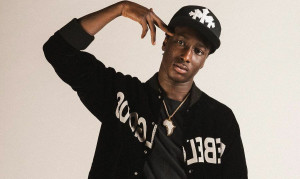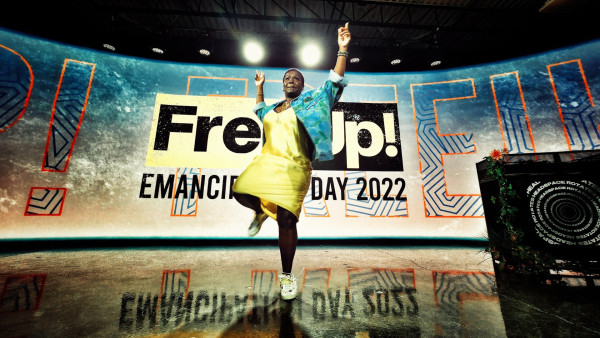As part of her study of how art, culture and education can be employed to illuminate complex issues that pertain to social justice, citizenship, belonging, and nationhood, Tier 2 Canada Research Chair of The Centre for the Study of Black Canadian Diaspora has launched The State of Blackness Project. Inspired by a 2014 two-day, interdisciplinary conference of the same name organized by Dr. Fatona, the digital project is to serve as a repository for information about the artistic production and dissemination of works by Black Canadian cultural producers, which includes artists, curators, craftspeople, art writers and critics. At a time when art institutions and publications are being placed under the microscope, forced to reevaluate their collections, coverage, critiques, boards and curators, perhaps now is the perfect time to unearth the past and present work of Black Canadian creators; those who laid the groundwork so the rest of us could have this moment now? I spoke to Dr. Fatona about the importance of The State of Blackness Project, inspirations, dedications, and her role as a translator between the art world and the community.
You are the Tier 2 Canada Research Chair for The Centre for the Study of Black Canadian Diaspora. Can you explain what it is and your role within the Centre?
I’m the principal researcher of The Centre and the Centre serves as the foundation for the research and development of the State of Blackness platform.
What is The State of Blackness Database Project?
It’s a project to archive and document the works of Black cultural producers, mainly artists, curators, craftspeople, art writers and critics, starting from 1987 to the present. It’s a way to preserve our history of engagement with the arts in Canada and a way to build a repository for future generations and make sure that Black Canadians are visible to each other in terms of our history of cultural production in this country.
Can you talk a bit about the different phases of the project?
The State of Blackness platform will house all of the research I will undertake, with other teams around the country, to locate the works, images, curators, and artists who created the works. We will collect those works by digitizing them, so there will be no physical representations of these exhibitions. We will also engage in what I’m calling the development of ‘meta-categories.’ Meta-categories are new categories to describe these works with the vocabulary and languages of the Black cultural groups who have created them and the cultures from which many of the groups come from. The second component of The State of Blackness platform is to write the algorithms that will drive the database. There’s been some deep, rigorous work done within the computing space that looks at how computer algorithms are themselves actually coded against Blackness. The algorithms can only ask or answer the questions that have been coded into them. The developers may have issues in terms of a racist paradigm that frames how a question is posed to a computer, which obviously affects the answer the computer will give My project seeks to ask different questions of the computer that are grounded in Blackness so the answers will come out of Blackness instead of just Euro-Western paradigms only.
Can you give me an example of this algorithm in action?
I’ll give an example using my cousin Winsom’s* work, which I’ve programmed and exhibited. The work comes out of an Afro-spiritual understanding of the world. So within the context of a Euro-Western understanding of the work, it might just be labelled as African spirituality. My cousin has a background that’s Jamaican and has travelled all over West Africa studying African spirituality. ‘Obeah’ is a practice in Jamaica that is based on African spirituality, and many of the signs and symbols in her work come out of Obeah. There are also ‘Veve’ Symbols drawn from Haitian spiritual practices in her work. So as a way to recategorize that, we could create categories like ‘Obeah’, ‘Veve’ or a range of other words so that more people would find the work. Otherwise, that work might not be found within the framing of it as African spirituality...it’s to try and add nuance to the cultural categories and reinfuse the cultural spaces out of which some of these works come out.
The State of Blackness platform is named after a two-day conference held at OCAD University and Harbourfront Centre for the arts in 2014 that you organized?
In 2014 I organized a two-day conference that brought together artists, curators, writers, academics, and students to talk about what we saw as some of the challenges to the production and presentation of Black artworks, art writing, and critical art writing in Canada. The project arose out of my research for my Ph.D. in which I was looking at Black cultural activism throughout the 80s and 90s that led to the opening up of arts funding at the Canada Council for the Arts, our federal funding arts body founded in the 1950s. I looked at the activism on the ground and the policies that formed the Canada Council and the policies that continue to drive funding and how race, and particularly Blackness, are disadvantaged in the context of arts funding. It led me to ask the question if we’re not getting arts funding, then what does the culture scape look like in terms of Black artworks and what does education look like in terms of what we’re teaching about Black artworks? Furthermore, what are we seeing in galleries? That was the discussion that took place in 2014. We came up with several recommendations that galleries, museums and institutions could take up to help shift the lack of access for Black folks in the country concerning art production and presentation.
Were you already thinking about taking on this project at the time, or did it come to you after that conference?
There were spin-off projects that came out of that conference, one of which where a group of us in 2015 went to the Venice Art Biennial, which is the oldest art fair in the world, because the late Okwui Enwezor* was the artistic director. Blackness descended upon Venice and we were there to represent Canada. While we were there we realized that, in the context of international conversations, Canada gets lost in terms of people knowing who produces art in this country. It forced me to think about what’s happening locally, nationally, and internationally, which led me to think about and develop this project to try and shift our position as Black cultural producers. I have to say it just cemented what I’d been thinking pre-conference and post-conference, which was the necessity for a number of sites where we could centralize our knowledge of who’s here and who’s making work. It was a role I knew I could and should play because I’ve also worked as a curator in different places across Canada, in both small towns and large cities. I have a sense of folks who have produced work and exhibitions that have taken place. So because of my history as a curator, I know there are histories out there that need to be preserved.
Speaking of preserving history, who is Ayanna Black and why is the site dedicated to her?
Ayanna Black was a poet, writer, and activist who co-founded the Canadian Artists Network: Black Arts in Action (CAN: BAIA) and ACCESS who brought us all together as Black cultural producers across the country. Ayanna was also instrumental in activism at the Canada Council for The Arts to allow for funding to be given to multi-disciplinary festivals. Because of that, she and other Black artists were able to produce Celafi: Celebrating African Identity, a festival that brought us all together and put us in discussion with a broader transnational Black cultural production community. I came into my being in relation to Black Canadian art at the same time these festivals came into being. For me, Ayanna and several folks set the stage for me to do this work, with these festivals that took place and created synergies amongst us. So the site is dedicated to her so that we remember who she is, and the ground she and others have created for us to continue to do the work today. I’m really into the notion of having embodied discussions about who we are and how we’ve come to this place, so the site also has a link that takes you to an audio document*** where you can hear Ayanna talk about her life in her own words. This is important in terms of making space for folks who have laid the groundwork for us who aren’t academics and won’t show up in the citation of books necessarily, but they are properly cited and given a space and the recognition they deserve concerning the present.
In this role, I come into contact with a lot of academics in the art world, and the theme of the moment appears to be “decolonization.” I often wonder though, if you can decolonize the art world while still using language to talk about art that comes from Western academic theory. People with working-class backgrounds, referring specifically to BIPOC communities, are often intimidated by this world in part, I believe, because of the language around it. What do you think is the role of academia in making these spaces feel more inclusive to these communities?
Well, I’ll talk about myself. I reside in academia but I see myself as being part of other communities. My role, with this work, is to be more of a translator that can open up space and use the appropriate language for the situation. So in the same way that you talk to your mother isn’t the same way you talk to your lover. I’ve been trained with a particular kind of language and way of seeing the world, but at the same time I can open up that language to move in and out of that world, so I can communicate what I need to my community.
So code-switching?
It is. Just as individuals in the world, we perform ourselves differently and are always switching code. We’re not the same in every context. So I know for me, it’s important to always be observant and understand who I’m in conversation with, to be able to shift accordingly so that we can be on the same level of understanding with each other. I do not believe in the total decolonization of the gallery system because it’s a colonial construct. I think there are things we can do to make these spaces self-reflective of their past to transform their present in certain ways, but I don’t think that colonial institutions can be de-colonized because they stem from a colonial root. That’s my take on things and I might be wrong, but these are the kind of spaces and ideas that I’m trying to traverse. I might change my mind in 5 years as I do this project and other ideas present themselves to me.
So it’s less about total decolonization and more about translating so that communities outside of that colonial model can also understand and feel welcome in those spaces.
That’s what I’m trying to do. I’m also trying to create the conditions under which, over time, we might be able to create our own spaces that start from our own frameworks and create something new. We have the imagination and the skills.
What do you believe is the importance of documenting the past work of Black artists and curators?
Documenting the past is important because we need to have an understanding of our past to be in the present in a grounded way and also to imagine what the future can be. Without that past, we tend to be unmoored, and this White supremacist, liberal-democratic framework in which we live tends to erase us because they know we can’t get grounded if we’re continually trying to make ourselves. I’m trying to help short circuit that; to say we understand the processes of our unmaking in order to stop this cycle of thinking of ourselves in this country as perennial newcomers. It does something to your psyche to think of yourself as always ‘just arriving’ and I believe laying the foundation down to say ‘we’ve always been here’ shapes the psyche and present differently. It gives you a more grounded sense that many things are possible for the future.
The State of Blackness Project: https://thestateofblackness.format.com/
Author’s Notes:
*Winsom is a multi-media installation artist whose instinctive works explore themes of freedom, survivance, resilience, renewal, and African spirituality within the context of the Black Atlantic experience. Dr. Fatona curated the AGO exhibitions, Winsom: The Masks We Wear and Jumping the Boa
**Okwui Enwezor was an influential Nigerian contemporary art curator whose large-scale exhibitions challenged the status quo of a Euro-American-centric art world by placing the perspectives of lesser-known diaspora artists front and centre.
***(Ayanna Black) A hyperlink in the dedication on the State of Blackness website takes you to an audio file on the Centre for Women's Education (CWSE) YouTube channel.

 By
By 








